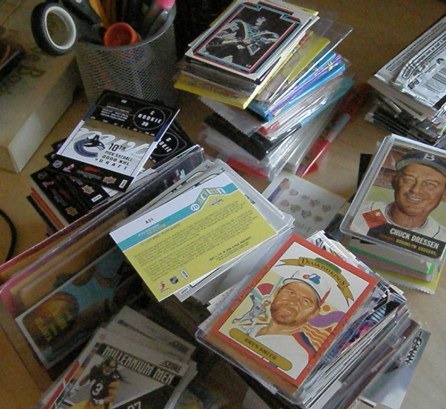The best way to organize baseball cards is by using binder sleeves and dividers within a dedicated storage system. Sort them by year, team, or player for quick access and efficient management.
Organizing baseball cards is crucial for both passionate collectors and casual enthusiasts. It’s not just about keeping them in mint condition; it’s also about creating a system where you can enjoy your collection and share it with others. By categorizing your cards effectively, you ensure that finding that rare rookie card or a favorite player’s career highlight is always a seamless experience.
With a variety of storage options available, from binders to boxes, and sorting criteria, such as by set, player, or team, you can tailor your organization method to suit your personal preferences and the size of your collection. Remember, a well-maintained collection increases in both sentimental and monetary value over time.
Introduction To Baseball Card Collecting
Introduction to Baseball Card Collecting sparks a journey through the rich history of America’s favorite pastime. Collectors from around the globe seek the thrill of finding, owning, and organizing these pieces of sports heritage. Whether you’re a seasoned pro or just starting, understanding how to sort and protect your cards is fundamental.
The Rise Of Sports Memorabilia
The allure of sports memorabilia has grown massively. Fans seek out anything from game-worn jerseys to signed equipment. Among these treasures, baseball cards stand out. They capture moments in history, preserve stats of legends, and serve as a testament to one’s love for the game.
Interest in memorabilia is not new, but the last few decades have seen a substantial increase in both value and demand. Rarity, condition, and the player featured dictate the card’s worth. Hence, proper organization becomes crucial.
The Charm Of Baseball Cards
- Each card is a snapshot of baseball lore.
- They represent players from rookie prospects to hall-of-famers.
- Their backstories add a layer of intrigue and nostalgia.
Baseball cards cater to more than just value; they carry a charm that encapsulates the spirit of the game. Balanced between hobby and investment, collecting these cards means embracing a legacy of American culture.
Organizing your collection not only showcases your passion but also ensures the longevity of these cherished items. Whether displayed in binders or secure cases, each card’s placement is a step towards creating your personalized archive of baseball history.

Credit: www.cardboardconnection.com
Determining Card Value
Understanding the value of your baseball cards is key to organizing them efficiently. Knowing what you have can help sort and prioritize your collection. Let’s explore how to determine a card’s true worth.
Evaluating Card Condition
Card condition impacts value significantly. Follow these steps to assess card quality:
- Check corners for sharpness.
- Look for surface scratches or creases.
- Inspect edges for smoothness.
- Ensure the card is free of stains.
- Use a centering tool to gauge alignment.
Employ plastic sleeves and hard cases to keep cards in top shape. Professional grading services can also determine precise conditions.
Researching Market Trends
Card prices fluctuate. Market trends dictate their current demand. Consider these tips:
- Explore online databases for recent sale prices.
- Analyze price guides for historical data.
- Follow sports news to anticipate demand surges for certain players.
- Participate in collector forums.
Average sales data from multiple sources gives a reliable value estimate. Rarity and significance also affect market value.
Sorting Your Collection
Everyone loves the thrill of adding new cards to their baseball collection. But without a good system, that pile of cards can turn into chaos! To keep your collection in MVP shape, let’s break down the best ways to sort them. This will make finding your favorite players or most precious cards a breeze. Remember to always handle cards with care to maintain their condition!
By Player And Team
Sorting by player and team is a classic method. It helps you track the careers of your favorite athletes and the success of teams across seasons. Start by creating piles for each team. Then, within those teams, sort the cards by player names. Use plastic sleeves or binders with tabs labeled with team names to protect and organize your cards.
| Team | Players |
|---|---|
| New York Yankees | Aaron Judge, Gerrit Cole |
| Los Angeles Dodgers | Mookie Betts, Clayton Kershaw |
Chronologically By Era Or Year
Arranging cards by era or year offers a historical perspective of the sport. It’s like having a timeline of baseball’s evolution. Create sections for different eras or decades, like the ’70s or ’90s. Within those, order the cards by year, either in binders or boxes. This system is perfect for history buffs and those who love to see how the game and players have changed over time.
- 1900s-1910s: Birth of Baseball Legends
- 1920s-1930s: The Golden Age
- 1980s-1990s: Modern Classics
Special Editions And Rarity
For collectors, special editions and rare cards are the jewels of a collection. Safeguard these unique finds in top loaders or high-quality sleeves. Organize them separately from regular cards. You might choose to sort them by the rarity level, promotional sets, or autographed editions. A detailed list can help you keep track of these treasures. Ensure they are stored in a secure, climate-controlled environment.
- Limited Editions
- Autographed Cards
- Promotional Items
Storage Basics
When organizing baseball cards, it’s essential to start with the basics. A good storage system protects your cards from damage, makes them easy to sift through, and showcases your collection.
Choosing The Right Protectors
Selecting top-notch protectors is crucial for keeping your cards mint-condition.
- Soft sleeves are a must for minimal protection.
- Consider top loaders for extra firmness.
- Card savers are perfect for sending cards for grading.
- Magnetic cases offer the best security for high-value cards.
Organizing In Binders And Boxes
Binders and boxes are classic choices for card collectors.
| Binders | Boxes |
|---|---|
| Good for display | Ideal for bulk storage |
| Easy to flip through | Stack effectively |
| Use plastic sheets | Vary in sizes |
To organized cards in binders:
- Sort by team, player, or year.
- Label the spine for easy access.
For boxes:
- Use dividers for categorization.
- Keep in a cool, dry place.
Cataloging And Inventory
The heart of a robust baseball card collection lies in proper organization. Cataloging and inventory management enable collectors to keep track of every card. This guide focuses on streamlining this process with the use of technology.
Creating A Digital Database
Digital databases transform cabinets full of baseball cards into easily accessible information. Start by choosing a database format like a spreadsheet. Input vital details such as player names, team affiliations, card conditions, and values. This data will make sorting and retrieving specific cards simple.
Here’s a quick template to follow:
Additional rows follow the same structure| Player Name | Team | Year | Condition | Value |
|---|---|---|---|---|
| John Doe | Yankees | 1992 | Mint | $100 |
Using Apps And Software
Apps and software designed specifically for collecting can track your baseball cards efficiently. Select from options that sync across devices, allowing updates on-the-go. Some apps even provide pricing guides and marketplace data. Popular choices among collectors include:
- Beckett Mobile
- Trading Card Database
- Zistle
With app or software help, you can safeguard your inventory with backups. Always ensure your digital records are up-to-date with your physical collection.
Displaying Your Cards
Displaying Your Baseball Cards can be as rewarding as collecting them. Show off your collection with pride and a touch of creativity. Framing and wall displays create a stunning visual showcase, while maintaining card integrity preserves your cards for years to come.
Framing And Wall Displays
Turn your baseball card collection into an art gallery on your walls. The right frame can make any card stand out.
- Card Mounts: Use individual card mounts for a sleek look.
- Shadow Boxes: Group your cards in a shadow box for a unified display.
- UV Protective Glass: Protect your cards from fading with special glass.
Ensure your frames match your room’s decor. This highlights your collection in the best way.
Maintaining Card Integrity
Preserving your cards is crucial. Choose your display materials carefully to prevent damage.
| Material | Benefit |
|---|---|
| Acid-Free Matting | Avoids chemical reactions that can degrade cards. |
| Archival Sleeves | Shields cards from dust, moisture, and handling. |
| Rigid Cases | Provides strong physical protection from bending. |
Remember to keep your displayed cards away from direct sunlight and high humidity areas.
Insurance And Security
Imagine your prized baseball cards, each carefully curated and preserved over the years. Think of the history, the memories, and the value they hold. Now, picture them gone in an instant due to theft or damage. The right insurance and security measures can shield your collection from such disasters, safeguarding your investment and the legacy of the game’s greats. Let’s dive into the best ways to protect your cardboard treasures.
Assessing The Need For Insurance
Determine the value of your collection through expert appraisals or price guides. Keep a record of each card, their condition, and their current market price. This will help you understand the level of insurance needed.
| Card | Condition | Market Price |
|---|---|---|
| Babe Ruth 1933 Goudey | Mint | $100,000 |
| Mickey Mantle 1952 Topps | Near Mint | $50,000 |
Once valued, choose an insurance policy that covers theft, loss, and damage. A specialized collectibles insurance might be more fitting than general homeowners’ policies.
Protecting Against Theft And Damage
Use secure display cases that are lockable and made with UV-protective glass to prevent fading and damage.
Install an alarm system in your home specifically for areas where you keep your collection.
Consider a safe-deposit box for the most valuable cards, especially if your collection is appraised at a high value.
For added security, keep digital backups of your inventory. Store pictures and a detailed spreadsheet securely in the cloud. This is crucial for insurance claims or police reports in case of theft.
Trading And Networking
Entering the world of ‘Trading and Networking’ transforms baseball card collecting. Explore ways to connect with fellow enthusiasts and swap cards to complete your collection. Embrace the digital age and increase your chances of finding rare cards through online communities.
Connecting With Other Collectors
Meeting others with the same passion significantly enhances the collecting experience. Join local clubs and attend card shows. Face-to-face interactions build lasting relationships and networks.
Use social media to find groups dedicated to baseball cards. Share your collection and discover others. Facebook groups and Instagram pages often lead to beneficial connections.
Trading Events And Online Platforms
Attending trading events is crucial for serious collectors. These events offer the perfect setting for swaps and deals. Annual conventions attract large crowds and offer rare finds.
Don’t miss out on online trading platforms:
- eBay: A vast marketplace with auctions and buy-it-now options.
- COMC (Check Out My Collectibles): Buy, sell, or trade cards easily.
- Beckett: Access price guides and forums for trading tips.
- Reddit: Subreddits for baseball cards can be goldmines for trades.
Maintenance And Upkeep
Baseball cards tell stories and hold memories. Keeping them pristine ensures they last for generations. Proper maintenance and upkeep are key. Here’s how to do it right.
Regular Dusting And Cleaning
Dust and grime can damage cards over time. Regular cleaning prevents build-up. Use a soft, dry cloth for dusting. Once a week should do. For tougher spots, a slightly damp cloth works. Be gentle.
- Soft-bristled brushes remove dirt without scratching.
- Microfiber cloths are great for absorbing moisture.
- Never use harsh cleaners or chemicals.
Handling Cards With Care
Cards are delicate. Always handle with clean, dry hands. Oils and moisture from your skin can harm them.
- Hold cards by the edges to avoid fingerprints.
- Use card sleeves for extra protection.
- Do not bend or snap the cards.
By following these tips, your baseball cards will stay in top condition. Remember, a well-maintained collection is more enjoyable and valuable.

Credit: venngage.com
Future-proofing Your Collection
Future-proofing your baseball card collection is an art. It involves smart strategies to keep your precious memorabilia safe and relevant for years. Think ahead to protect your cards from wear, tear, and the ever-changing market dynamics. Future-proof your collection to make it timeless.
Staying Updated With Trends
Baseball cards rise and fall in popularity, just like fashion.
- Join online forums and communities dedicated to collectors.
- Subscribe to collector magazines for the latest trends.
- Regularly check auction sites to see what’s hot.
Adapting to new trends keeps your collection valuable.
Passing On The Collecting Bug
Sharing your passion can make your collection immortal.
- Showcase your cards at local clubs or events.
- Start a baseball card blog to engage newer collectors.
- Gift duplicates to young enthusiasts to spark interest.
Mentoring can make your collection valuable for generations.

Credit: www.amazon.com
Frequently Asked Questions For Best Way To Organize Baseball Cards
How Do I Catalog My Baseball Cards?
Start by organizing baseball cards by year, set, or team. Use a cataloging app or spreadsheet for digital tracking. Protect cards with sleeves or binders. Update your catalog regularly to maintain an accurate collection record.
Is It Ok To Store Baseball Cards In A Binder?
Yes, storing baseball cards in a binder is acceptable. Ensure the pages are acid-free and the binder is stored in a cool, dry place. Use card sleeves for added protection.
How Do You Keep Track Of Baseball Cards?
To track baseball cards, create a digital inventory using software or apps specifically for collections. Organize cards in binders or boxes and categorize by year, team, or player. Regular updates ensure accuracy. Use spreadsheets for easy searching and tracking of card conditions and values.
Conclusion
Organizing baseball cards shouldn’t be a daunting task. Embrace these methods for a neat, well-curated collection. Whether through binders, boxes, or digital means, your cards can stay pristine. Your passion for collecting shines brighter with order. Step up your game and enjoy the sorted display!


